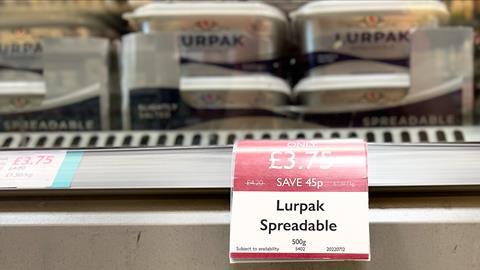The run-rate is more than double the typical number at this time of year, while Tesco is the retailer with the fewest price increases so far this year
As 2023 gets underway neither inflation, nor retailer efforts to convince shoppers they are combatting it, are showing much sign of letting up.
On the one hand, since Christmas, Sainsbury’s has increased the number of products in its Aldi Price Match campaign by about a third, to 310 (IPLC); Tesco announced a new price lock on more than 1,000 products until Easter; and Morrisons cut the price of 130 lines in its Savers range in a £16m investment, supported by a new ad campaign.
On the other hand, the new year is always a time when retailers push through price increases, and with broader inflationary pressure persisting, the number of price hikes was almost 10,000 for the second year running, according to research by The Grocer using Assosia data.
In fact, the 9,763 products increasing in price (from 156,555 grocery-based products) was slightly higher than the 9,103 recorded in January 2022.
Pushing through price hikes is not uncommon in the new year, says BRC economist Harvir Dhillon, “having held them in check as much as possible during the crucial Christmas trading period”. And as IPLC partner Paul Stainton points out, “branded agreements often roll over in the new year”, while new contracts on some commodities can also kick in at this time of year.
But at almost 10,000 the volume of price increases is unusual: more than double the usual run rate [Assosia].
So who is keeping price hikes to a minimum? And what’s happening across categories?
Holding back tide
The retailer doing most to keep prices down currently is Tesco: as a percentage of its range just 3% have gone up (see table).
“We always expect customers to tighten their belts after Christmas and that’s certainly what we have built in to the plan this year,” said Tesco group CEO Ken Murphy at its Q3 results this week.
In conjunction with a record 625 products in its Aldi Price Match scheme [IPLC] and other initiatives, “we are at the most competitive position we have been in for many years”.
Similarly, at Sainsbury’s Q3 results this week CEO Simon Roberts vowed to keep prices low again this year with its “biggest value campaign yet” but in relative terms there were significantly more price hikes (1,329) than at Tesco at 5%.
At the other end of the spectrum, the most price increases came at Asda, with 2,470 equating to 11% of its range.
It comes after Asda reported its strongest quarter since the start of 2021 in Q4 of 2022, with like for likes up 4.7%, as its new Just Essentials range drew in 400,000 new shoppers. An Asda spokesman said: “There are a number of reasons why grocery prices vary over time and during this period we also reduced prices on thousands of products.”
Waitrose also introduced a lot of compensatory price reductions: while 1,254 price increases represent 8% of its range, net price increases totalled 592, less than half.
Nor were the discounters unaffected. Aldi increased prices on 6% of its range, while Lidl did so on 7% of products.
They are not letting up on reminding shoppers of the savings they are still able to make, however. “I want to reassure you that Lidl is more committed than ever to our long-standing ‘Big on Quality, Lidl on Price’ promise,” wrote Lidl GB CEO Ryan McDonnell in an email to customers this week, citing Grocer 33 results from last year showing Lidl was cheapest.
Among categories, drinks saw the most price hikes, covering 11% of SKUs. This figure was higher among certain alcoholic drinks: 23% of beer and cider and 15% of spirits, but for wine just 7%.
It’s a knock-on effect of the category being a “key battleground in the run-up to Christmas” and promotions coming to an end, says Retail Economics senior consultant Josh Holmes.
Despite a wave of price increases across every category, Holmes believes reasons for optimism are emerging.
“Prices of key grocery inputs such as animal feed, fertiliser and energy are easing, alongside other core commodities such as maize and wheat,” he adds.
Unfortunately for shoppers, he says, “it will take some time for this to feed through to prices on supermarket shelves”.




















No comments yet